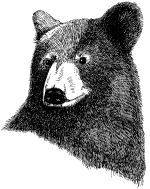
 |
 Biologists have been researching black bear in Michigan for nearly one-half century and know more about Michigan's black bear population and distribution than many other
wildlife species. Currently, Michigan contains approximately 12,000 bears statewide, with an estimated 10,000 living in the Upper Peninsula and 2,000 residing in the northern Lower Peninsula. Biologists have been researching black bear in Michigan for nearly one-half century and know more about Michigan's black bear population and distribution than many other
wildlife species. Currently, Michigan contains approximately 12,000 bears statewide, with an estimated 10,000 living in the Upper Peninsula and 2,000 residing in the northern Lower Peninsula.
Black bears often appear to be much larger than they are. Females typically weigh from 100 to 250 pounds, and males vary in weight from 150 to 400 pounds. Bears are usually heaviest in late fall prior to hibernating. Although they are large, heavy mammals, bears are surprisingly good swimmers and fast runners. In Wisconsin, one 200-pounder was clocked running 33 miles per hour. Bears are shy, reclusive animals that avoid direct contact with humans. Non-aggressive by nature, bears rarely attack people, except when threatened. In larger expansive forests, bears tend to live without conflict with humans. However, bear-human conflicts are on the rise due to habitat loss and human encroachment. The conversion of forested and wetland cover types to agriculture and other uses has forced bears to live in smaller geographic areas. Because of this, some bears have become habituated to people, especially when food is involved. Bears are opportunistic animals taking advantage of many foods. When prime food types such as fruits, nuts, plants, and insect larvae are limited, bears may turn to garbage dumps, bird feeders, livestock feeding stations, farm crops, campgrounds, and commercial bee huts to find food. When this occurs, bear-nuisance complaints rise dramatically. Managing for bears on your property may lessen these human-bear conflicts by providing the natural foods that they need. Life Cycle
Females (sows) produce a litter every other year, depending on food availability and each sow's health. When food supplies are short, the female may skip two or more years between breeding. The fetuses only develop if the sow has stored enough body fat to survive over-winter and provide milk for cubs until spring. By late January most pregnant females have given birth to an average of two or three blind, nearly naked cubs, each of which will weigh about a half-pound. By the time she leaves her den, the cubs will have gained 10 to 12 pounds, depending on the number of cubs. They will remain with their mother for 1 1/2 years. In Michigan, den sites are typically brushpiles, open nests, or excavations under standing trees. An open nest is created by bears breaking off twigs or branches for a base and then adding grass, tree bark, and leaves for bedding. Bears will also hibernate in caves, rock crevices, burrows, slash piles, windfalls, and other forest debris. Bears have even been known to den in old beaver houses, road culverts, and basements of abandoned homes. Seasonal Foods
In the breeding season, bears begin to look for wild strawberries, raspberries, blackberries, blueberries, thimbleberries, serviceberries, and wild sarsaparilla. These plants thrive in open areas such as clearcuts, abandoned apple orchards, logging roads, rights-of-way, and regenerated openings within hardwood stands.
Water must be readily available and well distributed thoughout the year. Black bears drink frequently when feeding on vegetation, nuts, or insects but seldom when eating berries. They wallow to cool off on hot days. Wetlands and wooded stream bottoms provide relief from heat, as well as important seasonal foods and denning sites. Bears use wetlands dominated by balsam fir, black spruce, and tamarack year-round. In the northern Lower Peninsula researchers found 68 percent of den sites in conifer-dominated wetlands, and the same preference is probably true in the Upper Peninsula. Management Considerations
Within your forest it is important to maintain both closed and open canopies. Closed canopies (close-growing trees whose thick crowns block sunlight) provide important security and escape cover for bears. Open canopies (trees which allow sunlight on the forest ground) support a dense understory that produces berries and other fruit. The understory will be dense with fruiting shrubs and there will be plenty of hard and soft mast food reserves. This combination of adequate food and inaccessible terrain typically includes a large geographic area. When food is not available, bears will wander great distances to find it. The following are options to consider when managing habitat for black bears:
In summary, bears and humans can live without conflict if large expansive forests and swamps are left unfragmented and food producing forest openings are maintained. It is important not to artificially feed bears and attempt to bring them around your house. They are a species that you can share your land with but should be admired from afar.
Last Revised: December 19, 1999 |
|